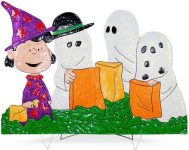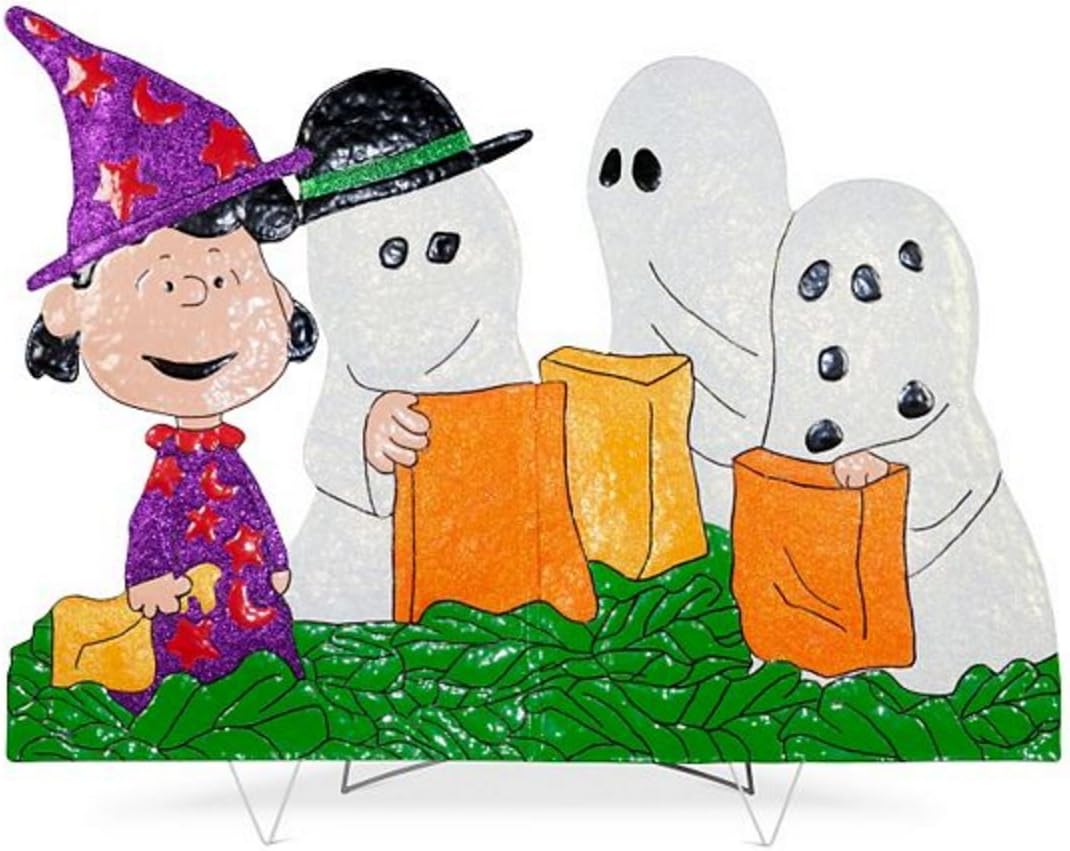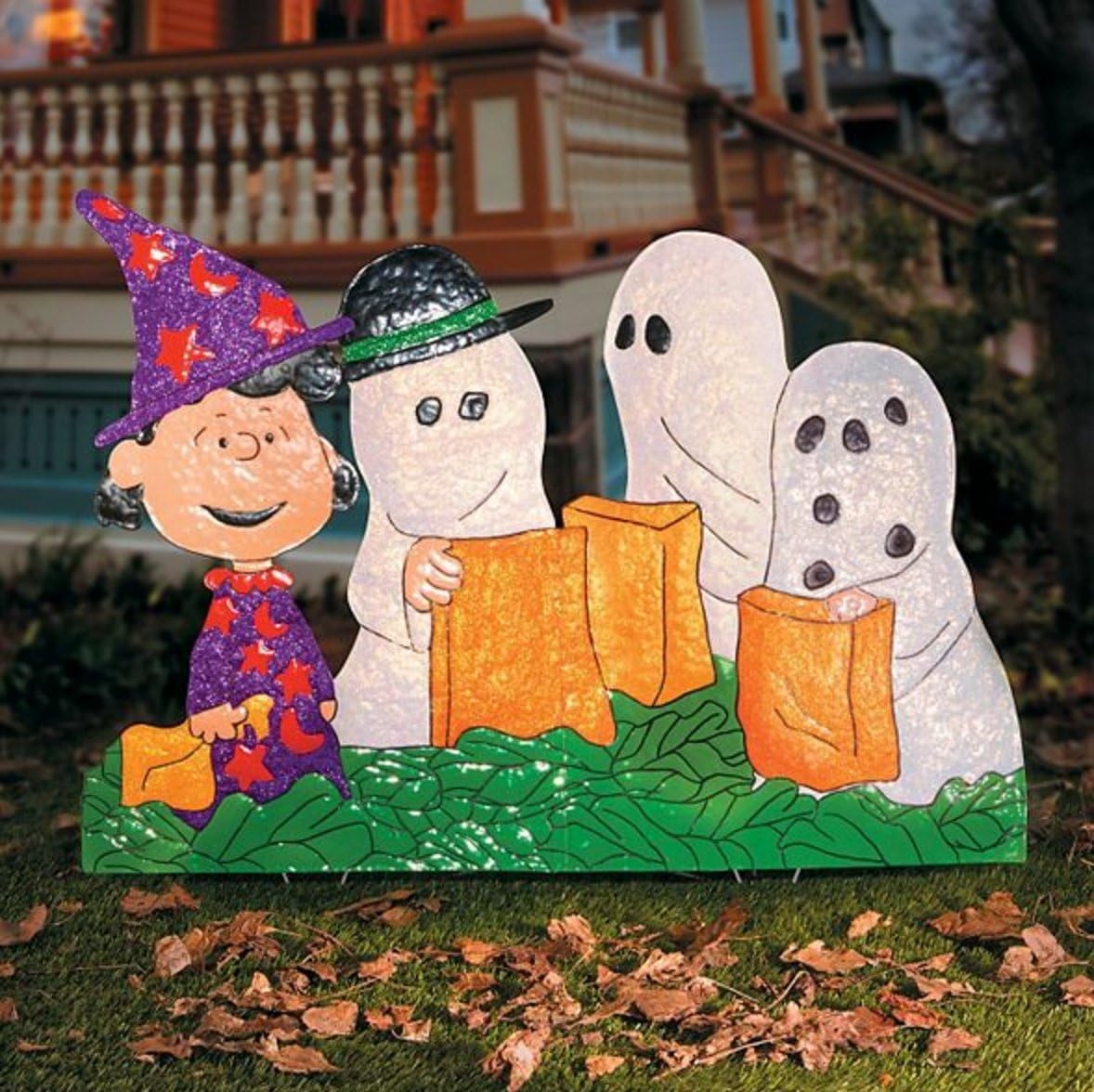
Peanuts Gang in Costumes Halloween Review Charlie Brown Halloween – Oemiu
Peanuts Gang in Costumes: A Halloween Review
The rustle of autumn leaves, the crisp night air, the gleam of jack-o’-lanterns – these are the telltale signs that Halloween is just around the corner. And for generations, no Halloween season has been complete without spending some time with the Peanuts gang in “It’s the Great Pumpkin, Charlie Brown.” This animated classic, a staple of the season, offers more than just nostalgic charm. It’s a masterclass in storytelling, character development, and the enduring power of childhood beliefs, wrapped in a package of delightfully simple animation and Vince Guaraldi’s iconic jazz score. More than just a cartoon, it’s a cultural touchstone that resonates with adults and children alike, exploring themes of faith, disappointment, and the importance of friendship. We all secretly hope that this is the year the Great Pumpkin actually arrives, and the anticipation is part of the fun.
The Enduring Appeal of “It’s the Great Pumpkin, Charlie Brown”
What makes “It’s the Great Pumpkin, Charlie Brown” so perpetually popular? It’s not just the nostalgia factor, although that certainly plays a part. The special taps into universal themes that resonate across generations. Charlie Brown’s enduring optimism, despite his constant misfortunes, is incredibly relatable. We’ve all felt like we’re missing out or that we’re somehow different, and Charlie Brown embodies that feeling. Similarly, Linus’s unwavering belief in the Great Pumpkin, despite the skepticism of everyone around him, represents the power of faith and the importance of holding onto your convictions, even when they seem absurd to others. This childlike faith is juxtaposed against the pragmatism (and sometimes outright meanness) of characters like Lucy and Violet, creating a dynamic that mirrors the complexities of real-life social interactions. The simplicity of the animation also contributes to its timelessness. The clean lines and expressive character designs make the special feel fresh and engaging, even decades after its initial release. The soundtrack, with its jazzy undertones and playful melodies, perfectly complements the visuals, creating an immersive and unforgettable experience.
The humor in “It’s the Great Pumpkin, Charlie Brown” is also surprisingly sophisticated. It’s not just slapstick or silly gags; it’s subtle, character-driven humor that arises from the interactions between the Peanuts gang. Snoopy’s elaborate fantasies, from his WWI Flying Ace persona to his improvisational dancing, provide moments of comic relief that break up the more serious themes of disappointment and disillusionment. Sally’s infatuation with Linus and her subsequent anger at being “stood up” by the Great Pumpkin offers a relatable glimpse into the emotional turmoil of young love. Even the minor characters, like Pig-Pen with his ever-present cloud of dust, contribute to the overall comedic effect. This blend of heartwarming sentimentality and dry wit is what makes “It’s the Great Pumpkin, Charlie Brown” such a cherished classic. Its simple yet profound exploration of childhood hopes and fears makes it more than just a Halloween special; it’s a reflection on the human condition itself. And who hasn’t wondered what a *Charlie Brown Halloween* party would really be like?
A Close Look at the Costumes of the Peanuts Gang
The costumes chosen by the Peanuts gang are a window into their personalities. They are surprisingly simple yet remarkably effective in conveying their individual quirks and aspirations. Charlie Brown, of course, attempts to dress as a ghost, but his costume is plagued by holes, symbolizing his inherent insecurity and lack of confidence. The holes reveal more of him than they conceal, suggesting that he can’t quite hide his vulnerabilities. He’s the perennial underdog, and even his costume reflects that. In contrast, Lucy dresses as a witch, a fitting choice for her bossy and often domineering personality. The witch costume reinforces her image as someone who is in control and who wields a certain amount of power, even if it’s just within the confines of her psychiatric booth.
Linus, ever the believer, doesn’t bother with a costume at all. He’s too busy waiting for the Great Pumpkin to arrive in his pumpkin patch. His dedication to his belief is his costume, in a way. He embodies the spirit of Halloween by focusing on the magic and mystery of the season, rather than simply dressing up for the sake of it. Sally, initially excited about trick-or-treating, ends up spending the night with Linus in the pumpkin patch, dressed in whatever she threw on, a testament to her impulsive nature. Snoopy, in his iconic WWI Flying Ace costume, steals the show with his elaborate fantasies and aerial battles with the Red Baron. His costume is a reflection of his vivid imagination and his desire to escape the mundane reality of being a beagle. The other children sport a variety of classic Halloween costumes, from princesses and pirates to cowboys and superheroes, each reflecting their own individual interests and desires. These costumes aren’t just for show; they’re an extension of their personalities, adding another layer of depth to the already rich tapestry of the Peanuts universe. The selection of these *Charlie Brown Halloween* costumes is simple and memorable.
| Character | Costume | Significance |
|---|---|---|
| Charlie Brown | Ghost (with many holes) | Represents insecurity and vulnerability |
| Lucy | Witch | Reflects her bossy and controlling personality |
| Linus | None (focuses on the Great Pumpkin) | Embodies faith and unwavering belief |
| Snoopy | WWI Flying Ace | Represents imagination and escapism |
The Musical Genius of Vince Guaraldi
No discussion of “It’s the Great Pumpkin, Charlie Brown” would be complete without acknowledging the genius of Vince Guaraldi. His jazz score is an integral part of the special’s appeal, creating a unique and unforgettable atmosphere. The music perfectly complements the visuals, enhancing the emotional impact of the story and adding a layer of sophistication that elevates it beyond typical children’s entertainment. Guaraldi’s music is more than just background noise; it’s a character in its own right, contributing to the overall narrative and shaping the viewer’s emotional experience.
The opening theme, “Linus and Lucy,” is instantly recognizable and has become synonymous with the Peanuts franchise. Its playful melody and syncopated rhythm perfectly capture the childlike energy and whimsical spirit of the characters. The use of piano, bass, and drums creates a warm and inviting sound that draws the viewer into the world of Charlie Brown and his friends. Other tracks, such as “The Great Pumpkin Waltz,” add a touch of melancholy and longing to the special, reflecting Linus’s unwavering faith and the disappointment that ultimately awaits him. Guaraldi’s ability to evoke such a wide range of emotions with his music is a testament to his skill and artistry. The music is subtle yet powerful, enhancing the emotional impact of every scene and creating a truly immersive experience. Even today, hearing the opening bars of “Linus and Lucy” is enough to transport many back to their childhoods, evoking memories of Halloween nights spent watching “It’s the Great Pumpkin, Charlie Brown” with family and friends. The *Charlie Brown Halloween* soundtrack is just iconic.
Guaraldi’s music not only complements the visuals but also provides a commentary on the characters and their actions. For example, when Snoopy is engaged in his WWI Flying Ace fantasies, the music becomes more dramatic and adventurous, reflecting the excitement and danger of his imaginary battles. When Charlie Brown is feeling down, the music becomes more subdued and melancholic, reflecting his sadness and disappointment. This subtle use of music to enhance the emotional impact of the story is what makes Guaraldi’s score so effective. It’s not just background music; it’s an integral part of the narrative, adding another layer of depth and complexity to the already rich tapestry of the Peanuts universe. His contribution solidified the connection between jazz music and animated holiday specials, influencing countless composers and filmmakers in the years that followed. The film’s soundtrack has been reissued and reinterpreted many times, demonstrating its lasting popularity and influence.
Lasting Lessons from the Great Pumpkin Patch
Beyond the costumes, the music, and the humor, “It’s the Great Pumpkin, Charlie Brown” offers several valuable lessons that resonate with viewers of all ages. One of the most important lessons is the importance of friendship and support. Even though Charlie Brown is often the target of ridicule and misfortune, his friends (even Lucy, in her own way) are always there for him, offering words of encouragement and helping him to pick himself up after he falls. This underscores the idea that even in the face of adversity, having a strong support system can make all the difference.
Another important lesson is the importance of embracing one’s individuality. Each member of the Peanuts gang has their own unique personality and quirks, and they are all accepted and loved for who they are. Charlie Brown’s insecurity, Lucy’s bossiness, Linus’s faith – all of these traits are celebrated as part of what makes them unique. This is a powerful message, especially for children who may be struggling to fit in or who feel like they are different from everyone else. The special encourages viewers to embrace their own individuality and to celebrate the differences that make them special. Linus’s blind faith teaches us about hope and dedication, even when faced with overwhelming doubt. His unwavering belief in the Great Pumpkin, despite the lack of evidence, highlights the power of faith and the importance of holding onto one’s convictions, even when they seem absurd to others. The *Charlie Brown Halloween* themes are simple and easy for children to understand.
The special also subtly explores the themes of disillusionment and disappointment. Linus’s ultimate realization that the Great Pumpkin is not real is a poignant moment that speaks to the inevitable loss of innocence that comes with growing up. However, the special also suggests that even in the face of disappointment, it’s important to maintain a sense of hope and to continue to believe in the possibility of something better. Charlie Brown’s constant misfortunes are a reminder that life isn’t always fair, but that it’s important to keep trying and to never give up. These are important lessons that can help viewers to navigate the challenges and disappointments that they will inevitably face throughout their lives. The underlying sweetness and positivity is what makes this special so enduring.
Frequently Asked Questions (FAQ)
Why is “It’s the Great Pumpkin, Charlie Brown” so popular?
Is it just nostalgia?
The popularity of “It’s the Great Pumpkin, Charlie Brown” stems from a combination of factors. Nostalgia certainly plays a role, as many adults grew up watching it and associate it with fond childhood memories of Halloween. However, the special’s enduring appeal goes beyond mere nostalgia. It tackles universal themes that resonate with audiences of all ages, such as the importance of friendship, the power of belief, and the inevitability of disappointment. The characters are relatable and well-developed, and the story is simple yet profound. The iconic jazz score by Vince Guaraldi also contributes significantly to the special’s charm and timelessness. Even though animation styles have changed drastically, the classic simplicity of the Peanuts gang continues to hold its own and appeal to families during the Halloween season.
What is the significance of Linus’s belief in the Great Pumpkin?
Linus’s unwavering belief in the Great Pumpkin represents the power of faith and the importance of holding onto one’s convictions, even when they seem absurd to others. He is the only character in the special who truly believes in the Great Pumpkin, and he dedicates himself wholeheartedly to waiting for its arrival. His faith is tested by the skepticism of his friends, but he remains steadfast in his belief. Ultimately, the Great Pumpkin never appears, but Linus’s faith remains unshaken. This can be seen as a metaphor for the importance of maintaining hope and believing in something, even when there is no tangible evidence to support it. It’s also a commentary on the nature of belief itself and the personal meaning we can derive from it.
How does the music of Vince Guaraldi enhance the special?
Vince Guaraldi’s jazz score is an integral part of “It’s the Great Pumpkin, Charlie Brown,” creating a unique and unforgettable atmosphere. The music perfectly complements the visuals, enhancing the emotional impact of the story and adding a layer of sophistication that elevates it beyond typical children’s entertainment. The opening theme, “Linus and Lucy,” is instantly recognizable and has become synonymous with the Peanuts franchise. Other tracks, such as “The Great Pumpkin Waltz,” add a touch of melancholy and longing to the special. Guaraldi’s ability to evoke such a wide range of emotions with his music is a testament to his skill and artistry. It’s not just background music; it’s an integral part of the narrative.
What lessons can be learned from “It’s the Great Pumpkin, Charlie Brown”?
“It’s the Great Pumpkin, Charlie Brown” offers several valuable lessons that resonate with viewers of all ages. The importance of friendship and support is a central theme, as the Peanuts gang sticks together despite their individual differences and misfortunes. The special also emphasizes the importance of embracing one’s individuality and celebrating the differences that make each person unique. Additionally, it explores the themes of disillusionment and disappointment, reminding viewers that life isn’t always fair but that it’s important to maintain a sense of hope and to never give up. These are important lessons that can help viewers navigate the challenges and disappointments that they will inevitably face throughout their lives.
Why do Charlie Brown’s attempts at trick-or-treating always fail?
Charlie Brown’s consistent lack of success during trick-or-treating highlights his role as the perpetual underdog. His ghost costume, riddled with holes, becomes a metaphor for his own vulnerabilities and insecurities. His attempts at receiving treats are consistently met with bad luck or indifference, further emphasizing his position as the “blockhead” of the group. This recurring theme of failure adds a layer of comedic pathos to his character, making him all the more relatable to viewers who have experienced similar feelings of inadequacy or disappointment. The fact that he only receives rocks in his bag is a classic example of Peanuts’ bittersweet humor.
What is the significance of Snoopy’s WWI Flying Ace fantasies?
Snoopy’s WWI Flying Ace fantasies provide moments of comic relief and escapism within the special. They allow him to transcend the limitations of his reality as a beagle and to imagine himself as a heroic figure engaged in thrilling adventures. These fantasies are also a commentary on the power of imagination and the importance of having dreams, even if they seem unrealistic. Snoopy’s alter ego provides a contrast to the more grounded and realistic experiences of the other characters, adding a layer of whimsicality and imagination to the story. His battles with the Red Baron are a highlight of the special, offering a visual spectacle that is both entertaining and visually striking.
How does the special reflect the anxieties and hopes of childhood?
“It’s the Great Pumpkin, Charlie Brown” perfectly captures the anxieties and hopes of childhood. The characters grapple with feelings of insecurity, disappointment, and the fear of being different. Charlie Brown’s constant misfortunes reflect the anxieties of not being good enough or of always being the one left out. Linus’s unwavering belief in the Great Pumpkin represents the hope and optimism that children often possess. The special also touches upon the theme of fitting in, as the children navigate the social dynamics of trick-or-treating and the Halloween party. By exploring these themes in a relatable and humorous way, the special resonates with viewers of all ages, reminding them of the joys and challenges of growing up.







